小学英语阅读课说课稿
五年级英语《Read and write》说课稿

五年级英语《Read and write》说课稿PEP教材从四年级开始出现这种课型,但五年级的读写课明显与四年级不同,其教学目标是:在有限的课堂时间内,读懂与单元话题相关的趣味对话或短文;完成检测学生阅读理解程度的练习;听、说、读、写四会掌握一组句子;适当扩展语言,完成一项综合运用所学语言的任务型语言活动。
本节课是在学生巩固Is there…?Yes,there is. No,there isn’t.相关句型基础上进行的读写教学。
通过阅读Wu Yifan与Sarah之间谈论假日照片的对话,复习巩固本单元已学词汇和There be句型的单数形式,并通过一些真实的情景,加以运用。
完成检测学生理解程度的填充句子等练习;听,说,读,写四会掌握功能句。
接下来我要对学生情况进行分析。
五年级学生已英语两年有余,在英语听说读写方面具有一定能力,而There be句型在整个小学英语教程中是一个难点,学生虽然已初步接触了一般疑问句Is there…?的用法,但还不扎实,落实到书写,也有一定的难度,需在本课中进一步感悟,进一步强化。
根据五年级学生特点,我主要借助多媒体和实物教学来呈现材料,激发学生的学习兴趣和求知欲,主要采取情景教学法和任务型教学法,以自然公园为主线,让学生在教师的引导下,通过感知、体验、实践、参与和合作等多法并用的方式 ___教学,促进学生语言实际运用能力的提高。
英语课程标准指出,基础教育阶段英语课程的总体目标是:培养学生的综合语言运用能力。
而综合语言运用能力又以学生语言技能、语言知识、情感态度、学习策略和文化意识五个方面的综合素养为基础。
基于以上认识,对教材的把握和对学生的分析,我确定以下教学目标:(1) 使学生能听说读写句型Is there …? Yes,there is. No,there isn’t.(2)学生能用Is there …? Yes,there is. No,there isn’t.谈论假日照片。
分级阅读英语说课稿模板

分级阅读英语说课稿模板尊敬的各位评委老师,大家好。
今天我将为大家介绍一节分级阅读英语课程的教学设计。
本节课的主题是“分级阅读”,旨在通过阅读不同难度的英文材料,提高学生的英语阅读能力和理解能力。
课程导入课程开始时,我会通过一个简短的热身活动来激发学生的兴趣。
例如,我会播放一段与本节课主题相关的英文歌曲,让学生跟唱,并引导他们讨论歌曲中出现的关键词和短语。
教学目标本节课的教学目标是:1. 培养学生的英语阅读兴趣。
2. 提高学生的词汇量和语法知识。
3. 训练学生的阅读理解和分析能力。
教学内容本节课的教学内容分为三个部分:- 第一部分:基础词汇学习。
我会列出与阅读材料相关的基础词汇,并解释它们的意义和用法。
- 第二部分:分级阅读。
根据学生的英语水平,我将提供不同难度的阅读材料,让学生选择适合自己的文章进行阅读。
- 第三部分:阅读后的讨论。
学生阅读完毕后,我会组织学生进行小组讨论,分享他们的理解和感受。
教学方法在本节课中,我将采用以下几种教学方法:- 互动式教学:鼓励学生积极参与课堂活动,通过提问和讨论来提高他们的参与度。
- 分组合作:将学生分成小组,让他们在小组内进行讨论和合作,以提高团队协作能力。
- 任务驱动:设置具体的阅读任务,让学生在完成任务的过程中学习和提高。
教学过程1. 导入阶段:通过歌曲或视频引入主题,激发学生兴趣。
2. 新课呈现:介绍基础词汇,确保学生对阅读材料中的关键词汇有所了解。
3. 分级阅读:学生根据个人水平选择阅读材料,进行独立阅读。
4. 阅读后讨论:组织学生进行小组讨论,分享他们的理解和感受。
5. 课堂小结:总结本节课的学习要点,强调分级阅读的重要性。
作业布置为了巩固课堂学习,我将布置以下作业:- 完成一篇阅读材料的摘要写作。
- 准备一个与阅读材料相关的简短演讲。
课程总结通过本节课的学习,学生不仅能够提高英语阅读能力,还能够在阅读过程中学习到新的词汇和表达方式。
分级阅读的方法能够帮助学生根据自己的水平选择合适的阅读材料,从而更有效地提高英语水平。
小学英语阅读课说课稿范文
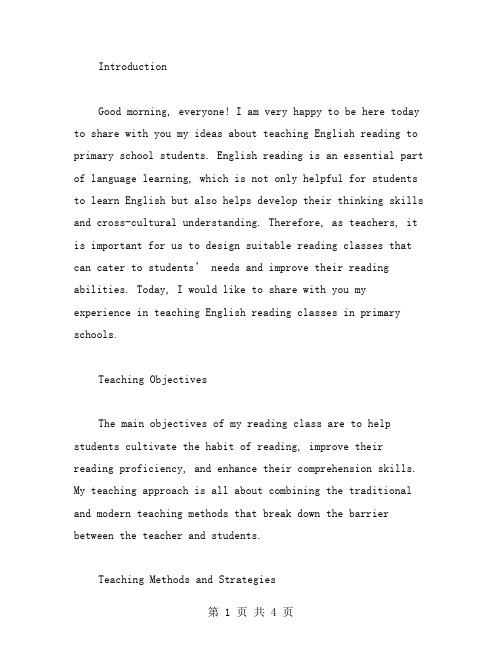
IntroductionGood morning, everyone! I am very happy to be here today to share with you my ideas about teaching English reading to primary school students. English reading is an essential part of language learning, which is not only helpful for students to learn English but also helps develop their thinking skills and cross-cultural understanding. Therefore, as teachers, it is important for us to design suitable reading classes that can cater to students’ needs and improve their reading abilities. Today, I would like to share with you my experience in teaching English reading classes in primary schools.Teaching ObjectivesThe main objectives of my reading class are to help students cultivate the habit of reading, improve their reading proficiency, and enhance their comprehension skills. My teaching approach is all about combining the traditional and modern teaching methods that break down the barrier between the teacher and students.Teaching Methods and StrategiesMy teaching strategies mainly include four aspects: engaging, activating, modeling, and guiding. Specifically, when it comes to a reading class, the first thing is to build a pleasant classroom atmosphere where students can feel comfortable, happy and engaged. For this purpose, I always start by arousing students’ interests through various media such as cartoons, music, games, and pictures that students are familiar with. For instance, I use different soundeffects to create an immersive reading experience to engage their interests.Secondly, activating refers to the process of connecting new knowledge to students’ prior knowledge. As a teacher, if we can relate new content to what students already know, students can learn more easily and comprehend better. To achieve this goal, I start by asking students questions about topics they are familiar with while gradually guiding them to acquire more knowledge.The third step is modeling. This allows students to observe and learn from the teacher’s behavior and mimic the language and pronunciation. As a teacher, I always model the correct usage of new words and phrases, and demonstrate howto read aloud in a clear and concise way. Through repeated practice, students can deepen their understanding of how to read correctly.Lastly, the guiding method helps students acquire more knowledge and enhances their comprehension skills. This strategy involves asking open-ended questions to encourage students to think critically and independently. For example, after reading a story, I ask questions like “Why do y outhink the character behaved that way?” “What do you think would happen if the story had a different ending?”Teaching ContentThe teaching content of my reading class mainly includes stories, articles, poems, etc. However, the choice of reading materi al can be customized according to the students’ interests, backgrounds, and proficiency levels. For students with lower proficiency levels, I tend to choose simpler reading material that they can easily understand. For advanced students, I may choose literature that challenges them but is still interesting.ConclusionIn conclusion, teaching English reading to primary school students is not just about imparting language knowledge, but also about helping students cultivate good reading habits, improving reading proficiency, and enhancing comprehension skills. Through engaging and interactive teaching strategies and suitable materials, I believe students can learn and excel in English reading step by step. Thank you forlistening!。
小学英语阅读课说课稿英文版

小学英语阅读课说课稿英文版Background of English teaching in primary school: It is not a long history that English is as a subject in primary school in our country and the main instructional aims of teaching English in primary school is to cultivate pupils’ basic abilities of their listening and speaking and their good sense of the English language. Our boys and girls are exposed to English for the first time, so it is very important to develop their keen interest in English.I. Contents:Today I’m going to talk about Part B of Unit 2, PEP Primary English, Book 3. This lesson includes two parts: Let’s talk and let’s practice. In section 1, it mainly deals with the dialogue about “What’s in the s choolbag?” and the answers. And in section 2, it provides a real situation for the Ss to prastise the pattern: How many +n.(pl.)+ do you have? And the answer: I have 23 +n.(pl.)II. Teaching aims1. Aims on the knowledge(1) To enable the Ss to un derstand and speak: “My schoolbag is heavy. What’s in it? Thank you sooooooo much.” Make sure that Ss can use these sentences in real situations.(2) To help Ss to finish the survey.(3) Let Ss finish the assessment of “Let’s check” in this unit.2. Aims on the abilities(1) To develop Ss’ abilities of listening and speaking.(2) To train the Ss’ ability of working in groups.(3) To foster Ss’ abilities of communication and their innovation.3. Aims on the emotion(1)To foster Ss’ consciousness of good co-operation and proper competition.(2) To lead Ss to show their loveliness to the poor.III. Key-points of this lesson(1) To help Ss ask and answer the question: What’s in it?(2) To enable Ss to study in groups and co-operate skillfully.(3) To develop Ss’ interest in English.IV. Difficult points(1) To help the Ss ask and answer the question “What’s in it?” and make sure they can use the plural nouns correctly.(2) To finish the survey by themselves.V. Teaching methodsAs we all know: the main instructional aims of learning English in primary school is to cultivate pupils’ basic abilities of listening and speaking and their good sense of the English language. So in this lesson I’ll mainly use “Task-based” teaching method. That is to say, I will letthe Ss learn in real situations, finish a task by making a survey to help the Ss to get a better understanding of the key structure of the dialogue. I will arrange four kinds of activities: singing, guessing game, finishing a survey and having a competition. And in this lesson a recorder, CAI, school things and a printed form will be needed. Students should prepare some school things.VI. Teaching procedures and purposes of my designing.I’ll finish this lesson in five steps.Step 1. Warm-up and preview1. Free talk between T and Ss about things in the classroom.2. Sing the song together: Books and pencils.3. Do some TPR, for example: Show me your English book. Show me your crayon.4. Review the numbers by asking: “How many crayons do you have?”Purpose: It is important to form a better English learning surrounding for the Ss by singing and doing some total physical response and at the same time it provides situations to review learned knowledge for the next step.Step 2. PresentationNow I’ll mainly talk about this step.1. Present the pattern: “My schoolbag is heavy.” “What’s in it?.”(1) Show a bag and say: “Look! I have a bag.” Carry it and say: “Oh, it is heavy. My schoolbag is heavy.” Help the Ss understand the meaning with the help of my body language. Then lead the Ss to read the sentence. Make sure they can say it correctly.(2) T: My schoolbag is heavy.Open the bag and say: “What’s in it? What’s in my schoolbag?”Take out a Chinese book. Then do the action again. Let the Ss read the sentence.2. Play a guessing game. Divide the whole class into four groups to have a competition.Let them guess: What’s in the bag? How many? Purpose: To present the key structures one by one is much easier for the Ss to learn and grasp the meanings. Proper competition can arouse the Ss’ interest in English learning.3. With the help of the CAI to present the dialogue. Set a situation to help Ss understand: Two Ss are coming. One girl is carrying a heavy bag on her back. They are talking.Girl: My schoolbag is heavy.Boy: What’s in it?Girl: 20 story-books, 32 pencil, 9 rulers, 12 crayons and 30 picture-books. Etc.Boy: What will you do?Girl: They are for the poor.Bo y: Great! I’ll bring some school things too.The boy comes back home and puts a lot of things into the bag. Then he goes to school again and gives them to a teacher. While he is taking them out, he is counting the numbers of all things. The teacher says: Thank you soooooooo much.4. Mention that we should take care of the poor.5. Play the cassette. Let the Ss listen and imitate the dialogue.Pay attention to their pronunciation and intonation. Purpose: CAI can provide a real situation for the Ss to understand the dialogue and the relationships between people better. Tell the Ss we should show our loveliness to the Ss.Step 3. PracticeDivide Ss into groups of six children. Each one would finish the printed form by asking and answering: How many storybooks do you have? Find out which group finishes faster. Story books picture-books sharpeners crayons pencils erasers pencil-cases rulers Chen Jie 8 24 3 32 26 4 1 3 Purpose: Task-based teaching method is used here to develop Ss’ ability of communication and also their ability of co-operation will be well trained.Step 4. AssessmentHelp Ss finish “Let’s check” of this unit and workbook.Purpose: To check the knowledge Ss have learned in this period.Step 5. Add-activity1. Let Ss tell each other how many school things they have after class. Tell their parents how many school things they have at home.2. Take care of everything they have.Purpose: Revision is so important that Ss should speak English as much as they as in class or after class. It is necessary for the Ss to do some extensive exercises after class to consolidate the knowledge they learned.。
说课稿小学英语阅读模板

说课稿小学英语阅读模板尊敬的各位老师,大家好。
今天我将为大家展示一节小学英语阅读课的教学设计。
本节课的主题是“Friendship”,旨在通过阅读活动,让学生理解友谊的重要性,并学会用英语表达对朋友的感情。
课程导入:首先,我会通过播放一首关于友谊的英文歌曲来吸引学生的注意力,如《You've Got a Friend》。
歌曲播放完毕后,我会引导学生讨论他们对友谊的理解,并询问他们是否有特别的朋友。
词汇学习:接下来,我会展示一些与友谊相关的词汇卡片,如“friend”, “helpful”,“supportive”等,并让学生跟读,确保发音准确。
之后,我会设计一些简单的词汇游戏,如“快速拼写”或“单词接龙”,以帮助学生记忆这些词汇。
阅读材料:本节课的阅读材料是一篇简短的故事,讲述了两个朋友如何互相帮助,共同解决问题的故事。
在学生阅读之前,我会先介绍故事的背景和主要人物,以帮助学生更好地理解文本内容。
阅读理解:在学生阅读故事后,我会提出一些问题,如“故事中的主要人物是谁?”,“他们遇到了什么问题?”,“他们是如何解决问题的?”等,以检查学生对故事的理解程度。
角色扮演:为了加深学生对故事的理解,我会组织学生进行角色扮演活动。
学生将被分成小组,每组选择一个角色,然后根据故事内容进行表演。
这不仅能锻炼学生的口语表达能力,还能让他们更深入地理解友谊的意义。
情感教育:在角色扮演活动结束后,我会引导学生讨论友谊的重要性,并鼓励他们分享自己的友情故事。
通过这种方式,学生能够更好地理解并珍惜自己的朋友。
作业布置:最后,我会布置一项作业,让学生写一篇短文,描述他们最好的朋友以及他们之间的友情故事。
这不仅能巩固学生在课堂上学到的知识,还能激发他们用英语表达自己情感的兴趣。
课程总结:在课程的最后,我会总结今天的学习内容,并强调友谊在人生中的重要性。
同时,我会鼓励学生在日常生活中多与朋友交流,培养深厚的友谊。
通过这节课,我相信学生们不仅能够学习到与友谊相关的词汇和表达方式,还能够更深刻地理解友谊的价值,并学会在生活中珍惜和维护友谊。
小学英语阅读课说课稿
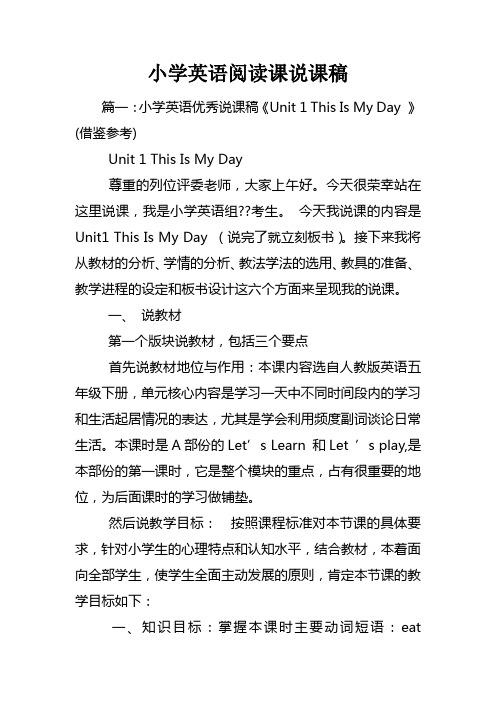
小学英语阅读课说课稿篇一:小学英语优秀说课稿《Unit 1 This Is My Day 》(借鉴参考)Unit 1 This Is My Day尊重的列位评委老师,大家上午好。
今天很荣幸站在这里说课,我是小学英语组??考生。
今天我说课的内容是Unit1 This Is My Day (说完了就立刻板书)。
接下来我将从教材的分析、学情的分析、教法学法的选用、教具的准备、教学进程的设定和板书设计这六个方面来呈现我的说课。
一、说教材第一个版块说教材,包括三个要点首先说教材地位与作用:本课内容选自人教版英语五年级下册,单元核心内容是学习一天中不同时间段内的学习和生活起居情况的表达,尤其是学会利用频度副词谈论日常生活。
本课时是A部份的Let’s Learn 和Let ’s play,是本部份的第一课时,它是整个模块的重点,占有很重要的地位,为后面课时的学习做铺垫。
然后说教学目标:按照课程标准对本节课的具体要求,针对小学生的心理特点和认知水平,结合教材,本着面向全部学生,使学生全面主动发展的原则,肯定本节课的教学目标如下:一、知识目标:掌握本课时主要动词短语:eatbreakfast,do morning exercises,have English class,play sports,eat dinner。
二、能力目标:能够听懂问句:When do you do morning exercises/...?并能运用所学动词短语替换句型“I usually ... at ...中的关键词回答问句。
3:情感目标:引导学生养成良好的作息习惯。
最后说教学重难点,其中重点是掌握Let’s learn 中的五个动词短语,并能用这五个短语回答询问作息时间的问题。
难点是掌握五个短语和单词exercises,usually 的正确发音。
二.说学请学生在上册已经对相关内容有部份了解,对时间的表达也比较熟悉,已掌握了必然数量的动词短语如do homework,play football,watch TV,play computer games等。
六年级上册英语说课稿《Unit4Ihaveapenpal-5Readandwrite》人教(PEP)

六年级上册英语说课稿《Unit4 I have a pen pal-5 Read and write》人教(PEP)一. 教材分析《Unit 4 I Have a Pen Pal-5 Read and Write》是人教版PEP小学英语六年级上册的一篇阅读写作课。
本节课主要讲述了关于介绍自己的兴趣和爱好以及与笔友互相了解和交流的内容。
通过本节课的学习,学生能够进一步巩固和运用本单元所学的词汇和句型,提高阅读和写作能力。
二. 学情分析六年级的学生已经具备了一定的英语基础,对于本单元的词汇和句型,大部分学生已经能够熟练掌握。
但是,部分学生在阅读和写作方面还存在一定的困难,因此,在教学过程中需要针对这部分学生进行针对性的辅导。
三. 说教学目标1.知识目标:学生能够阅读并理解关于介绍自己的兴趣和爱好的短文;学生能够运用本节课所学的词汇和句型,书写一篇介绍自己兴趣和爱好的短文。
2.能力目标:学生能够通过阅读,获取和处理信息,提高阅读理解能力;学生能够通过写作,提高自我表达和创作能力。
3.情感目标:学生能够激发对英语学习的兴趣,增强学习自信心。
四. 说教学重难点1.重点:学生能够阅读并理解关于介绍自己的兴趣和爱好的短文;学生能够运用本节课所学的词汇和句型,书写一篇介绍自己兴趣和爱好的短文。
2.难点:学生能够正确运用本节课所学的词汇和句型,流畅地表达自己的兴趣和爱好。
五. 说教学方法与手段1.教学方法:采用任务型教学法,让学生在完成任务的过程中,提高阅读和写作能力。
2.教学手段:利用多媒体课件,为学生提供生动直观的学习资源;利用小组合作学习,激发学生的学习兴趣,提高学生的学习积极性。
六. 说教学过程1.Pre-reading:教师通过提问方式,引导学生谈论自己的兴趣和爱好,激发学生的学习兴趣。
2.While-reading:学生自主阅读课文,回答相关问题;教师针对学生回答进行点评和引导。
3.Post-reading:学生根据课文内容,完成相关练习;教师针对学生回答进行点评和指导。
英语阅读法说课稿(通用5篇)

英语阅读法说课稿英语阅读法说课稿(通用5篇)作为一名人民教师,就不得不需要编写说课稿,说课稿有助于提高教师理论素养和驾驭教材的能力。
我们该怎么去写说课稿呢?下面是小编为大家整理的英语阅读法说课稿(通用5篇),欢迎阅读与收藏。
英语阅读法说课稿1设计理念:成功的英语教学要依赖大量的语言材料和语言实践。
阅读就是其中一种重要的学习途径。
基于小学生的认知特点和本着轻松愉快阅读英语的理念,我开展了结合教学实际,利用网络资源,开展网络环境下小学英语阅读课的尝试。
希望利用网络上丰富资源,补充阅读材料,利用电子书的直观,营造情景教学气氛,利用与学生与电脑互动的条件,把所学的旧知识放在新的语言情景中运用。
设计内容:运动为主题,设计专题阅读网站,突破本学期学习重难点:动词分词的用法。
所以结合本学期的重点和难点:动词的分词形式的意思和用法。
设计有关运动的专题阅读网站,里面有经过老师筛选过的适合学生程度和与所学知识主题相符合的的flash电子书和相关练习、游戏。
学习目标:学生通过阅读两篇必读文章,了解动词go –ing的搭配和能够给双写动词ing分类。
阅读选读文章,写出阅读海报。
学生通过阅读电子书,理解动词分词的各种形式变化及在文章中的意思,从而对阅读产生兴趣。
教学应用:下面是我的教学过程。
一、猜一猜、唱一唱、以趣激情,进入状态。
在热身的环节,学生猜运动名称,唱忙碌的小蜜蜂这首歌,听歌填单词,通过唱歌对Buzz这只小蜜蜂产生了浓厚的兴趣。
由此引出Buzz很忙,为下面的阅读驱动作了铺垫。
请看实例。
二、练一练、做一做、人机交互,语言实践。
(消声影片)阅读小蜜蜂的冒险故事电子书,这个故事有声音,动画的演绎,读的过程还有互动,所以基本上学生们都能够投入把老师布置的阅读练习做完,做对。
不但如此,在故事中出现的一些短语,短句也很有意思,比如说His face goes green。
他吓得脸都变绿了。
有助于学生自己习得语言,拓展学生的词汇量。
小学英语读写课说课稿模板

小学英语读写课说课稿模板尊敬的各位评委老师,大家好。
今天我要进行说课的课程是小学英语读写课,课程的主题是“我的家庭”。
本节课旨在通过阅读和写作活动,让学生能够描述家庭成员并表达对家人的情感。
课程目标:1. 知识与技能:学生能够理解并使用描述家庭成员的词汇和句型。
2. 过程与方法:通过小组合作和角色扮演等活动,提高学生的英语口语表达能力和写作技巧。
3. 情感态度与价值观:培养学生对家庭的热爱和对家人的感激之情。
教学重点:- 家庭成员的英文表达。
- 描述家庭成员外貌和性格特征的句型。
教学难点:- 学生能够灵活运用描述家庭成员的句型进行写作。
教学准备:- 家庭主题的图片和卡片。
- 相关的英语词汇表。
- 写作练习纸和笔。
教学过程:1. 导入(Lead-in):- 通过展示家庭主题的图片,激发学生的兴趣。
- 提问学生关于家庭成员的简单问题,如“Who is in yourfamily?”等。
2. 呈现(Presentation):- 教授描述家庭成员的词汇,如father, mother, brother, sister等。
- 通过图片和卡片,教授学生如何描述家庭成员的外貌和性格。
3. 练习(Practice):- 分组进行角色扮演,每个学生轮流描述自己的家庭成员。
- 教师提供句型模板,如“My father is tall and strong. He is very kind.”4. 应用(Application):- 引导学生进行写作练习,让他们写下关于自己家庭成员的短文。
- 教师巡回指导,帮助学生纠正语法和拼写错误。
5. 总结(Summary):- 邀请几位学生分享他们的写作作品。
- 教师总结本节课学到的词汇和句型。
6. 作业(Homework):- 要求学生回家继续练习写作,描述一个家庭成员,并在下节课上进行分享。
教学反思:本节课通过多种活动,让学生在轻松愉快的氛围中学习英语。
通过角色扮演和写作练习,学生能够更好地掌握描述家庭成员的英语表达。
英语阅读课说课稿英文版

英语阅读课说课稿英文版Title: English Reading Course Tutorial Speech (English Version)Dear classmates,Today, I would like to share with you my perspective on the English reading course. As a language learner, I believe that reading is one of the most effective ways to improve our English skills. Not only can it help us expand our vocabulary and improve our grammar, but it can also enhance our listening and speaking abilities.In the English reading course, we should focus on selecting high-quality materials that are appropriate for our language level. It is important to choose materials that are challenging but not too difficult, so that we can still enjoy the reading process. Additionally, we should practice our reading comprehension skills by trying to understand the meaning of difficult words and phrases, as well as the overall context of the text.In addition to reading, we should also try to incorporate other language activities into our daily routine, such as listening, writing, and speaking. These activities can help us build our language skills in a more comprehensive and effectiveway.To sum up, I believe that the English reading course is an essential part of our language learning journey. By selecting the right materials and practicing our reading comprehension skills, we can effectively improve our English language abilities and achieve our language learning goals.Thank you.拓展:The English reading course is an essential part of any English language learning program. Reading is a crucial skill that needs to be developed in order to improve one"s English language proficiency. As language learners, we need to immerse ourselves in English language materials and try to understand their meaning and context.In addition to reading, it is also important to practice other language activities, such as listening, writing, and speaking. These activities can help us integrate our language skills and develop a more comprehensive understanding of the English language.When it comes to selecting reading materials, it is important to choose materials that are challenging but not too difficult. We should focus on selecting materials that areappropriate for our language level and interest level. Reading materials from different genres, such as fiction, non-fiction, and humor, can provide us with a diverse range of language and cultural experiences.In conclusion, the English reading course is an essential part of any English language learning program. By selecting the right materials and practicing our reading comprehension skills, we can effectively improve our English language abilities and achieve our language learning goals.。
五年级上册Unit 1 What's he like? Read and write说课稿

五年级英语上册Unit 1 What’s he like? Read and write说课稿各位领导、老师们:大家上午好!今天,我说课的内容是PEP小学英语五年级上册Unit1 What’s he like?第六课时。
一、说教材1、教学内容分析本课为人教版小学英语五年级上册第一单元第六课时的阅读教学。
Read and Write分为读、写两部分:第一部分内容为日记形式,要求学生借助图片阅读吴一凡日记中的四段文字,选择描述机器人特征的单词;第二部分为仿写句子活动,要求设计一个机器人并写出描述其特征的句子。
句子结构已经给出,学生可以参考日记中的句子或者本单元学习的句型写出自己的句子。
2、教材所处的地位和作用本单元重点介绍如何描述他人(teachers or friends)的基本性格特征,由于四年级已经接触过一些介绍人物的外貌特征知识,学生对本单元相对容易接受。
在刚刚学过介绍老师和朋友特征的基础上,很自然的引入本课时的学习。
对于Robin的人物性格特点能很快掌握,并能根据其特点设计自己的机器人。
3、教学目标:(1)语言知识目标:能够在语境中理解robot,made,speak,finish的意思;能够按照正确的语音、语调朗读日记。
(2)语言技能目标:能够在图片的帮助下读懂日记;能够设计一个机器人并写出几个描述其特征的句子。
(3)学习策略目标:能够借助图片和听力获取信息,选出描述Robin的单词。
(4)情感态度目标:通过观察和设计机器人,让学生了解机器人对我们生活所带来的便利之处,促使学生更加勤奋的学习,创造出更多对人类有帮助的机器人。
4、说教学重、难点(1)教学重点:理解日记内容并按照正确的意群及语音、语调朗读日记;根据听和读日记的内容完成任务卡;写出几个描述机器人特征的句子。
(2)教学难点:能够在语境中理解robot,made,speak,finish的意思;写出几个描述机器人特征的句子。
二、说学情五年级学生,他们大多聪明活泼,乐于思考。
PEP六年级上册-Read-and-write说课稿
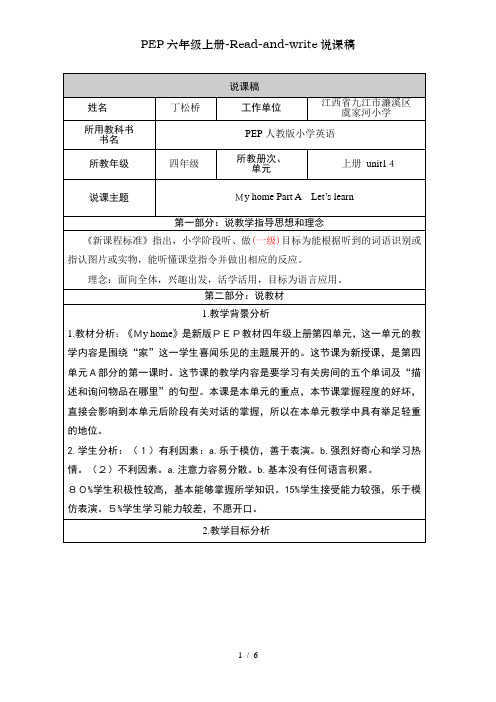
况。
2. Read it better①Task 1: Listen carefully and pay attention to sentence stress, pauses and intonation.②Task 2: Follow the radio and imitate.③Task3: Read together.④Task4: Read in pairs.(teacher find two students to read the passage loudly)⑤Task5:Retell the main content of the diary 通过听音,正音,大声朗读,复述日记内容等阅读活动,检验和培养孩子阅读能力。
步骤4. ⅣPost-reading1. Read a passage and answer the questionsWhat’s he like?I have a big class. I have many friends. Oliver is new here,he is funny and polite. Amy is my best friend, she is quiet and very hard-working. Ms Wang will be our new Chinese teacher. She’s kind but sometimes she’s strict.Questions: 设计意图: 1.丰富学生阅读内容。
2.训练学生阅读能力。
3.检验孩子书写能力。
2. Introduce your friend or teacherI have a (friend / teacher) _____! His / Her name is_________. (He / She) is _________________________.young funny kind strict politehard- working helpful clever shyfriendly strong tall short …设计意图:培养孩子看图写话的能力步骤5. ⅤEnding1. emotional education给学生讲述“三人行,必有我师”的格言,鼓励大家互相学习,共同促进。
小学英文阅读指导教案模板
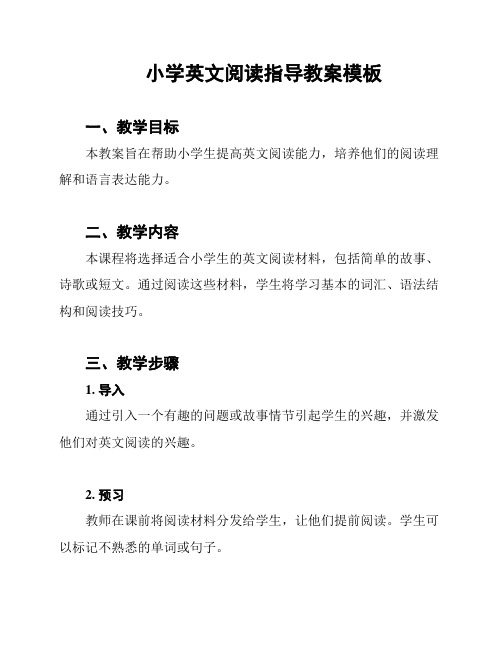
小学英文阅读指导教案模板一、教学目标本教案旨在帮助小学生提高英文阅读能力,培养他们的阅读理解和语言表达能力。
二、教学内容本课程将选择适合小学生的英文阅读材料,包括简单的故事、诗歌或短文。
通过阅读这些材料,学生将学习基本的词汇、语法结构和阅读技巧。
三、教学步骤1. 导入通过引入一个有趣的问题或故事情节引起学生的兴趣,并激发他们对英文阅读的兴趣。
2. 预习教师在课前将阅读材料分发给学生,让他们提前阅读。
学生可以标记不熟悉的单词或句子。
3. 阅读学生在课堂上朗读阅读材料,并尝试理解其中的内容。
教师可以提供适当的指导,帮助学生理解文章的主旨和细节。
4. 讨论教师与学生一起讨论阅读材料中的问题和观点。
学生可以分享自己的理解和观点,并与同学进行互动交流。
5. 语言拓展教师可以引导学生学习新的词汇和语法结构,以丰富他们的语言表达能力。
6. 写作练习学生可以根据阅读材料进行写作练习,包括写一篇文章、写一封信或进行简短的写作任务。
7. 总结教师与学生一起总结本节课的学习内容,并鼓励学生继续阅读和学习英文。
四、教学评估教师可以通过观察学生的阅读表现、听取学生的观点和评估学生的写作作品来评估他们的英文阅读能力。
五、教学资源教师准备合适的英文阅读材料、课堂讲义、词汇表等资源,以支持学生的学习。
六、教学延伸教师可以鼓励学生在课后继续阅读英文材料,并提供相关的阅读推荐和学习资源。
七、教学反思教师应及时反思教学过程,总结教学经验,并根据学生的实际情况进行相应的调整和改进。
以上为小学英文阅读指导教案模板,根据实际教学情况和学生的需求,可以适当调整和修改。
希望能对您的教学工作有所帮助!。
《PEP小学英语》第四册Unit5 B Read and write说课稿
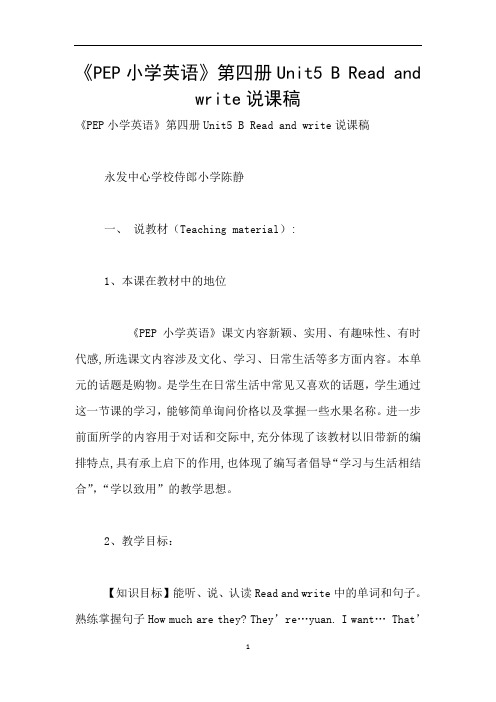
《PEP小学英语》第四册Unit5 B Read andwrite说课稿《PEP小学英语》第四册Unit5 B Read and write说课稿永发中心学校侍郎小学陈静一、说教材(Teaching material):1、本课在教材中的地位《PEP小学英语》课文内容新颖、实用、有趣味性、有时代感,所选课文内容涉及文化、学习、日常生活等多方面内容。
本单元的话题是购物。
是学生在日常生活中常见又喜欢的话题,学生通过这一节课的学习,能够简单询问价格以及掌握一些水果名称。
进一步前面所学的内容用于对话和交际中,充分体现了该教材以旧带新的编排特点,具有承上启下的作用,也体现了编写者倡导“学习与生活相结合”,“学以致用”的教学思想。
2、教学目标:【知识目标】能听、说、认读Read and write中的单词和句子。
熟练掌握句子How much are they? They’re…yuan. I want… That’s…yuan.【技能目标】提高学生听、说、读、演的能力,培养学生熟练运用日常交际用语进行购物的语言交际能力和观察、实践和创新的能力。
【情感策略目标】培养学生在活动中互助合作,发展合作精神,并能礼貌与人交际,在较为真实的场景中主动、灵活地运用语言,在生活中快乐地使用英语。
培养学生一定的理财能力。
不能乱花钱、乱购物。
3、教学重点和难点:本课时的教学重点是:会灵活运用How much are they? They’re…yuan. I want… That’s…yuan.难点是在情景中灵活运用表示数字的英语。
4、教学准备:水果图片、售货员的帽子、游戏用的钱币、相关的多媒体辅助课件和VCD、教室布置成模拟水果店的情景。
二、说教法(Teaching methods)根据《英语新课程标准》、学生的认知规律,小学阶段的英语教学应实施“趣味教学”,“以学生为主体,以活动为载体”本课时我采用如下教法:1、情景教学法。
小学英语阅读教学说课稿模板范文
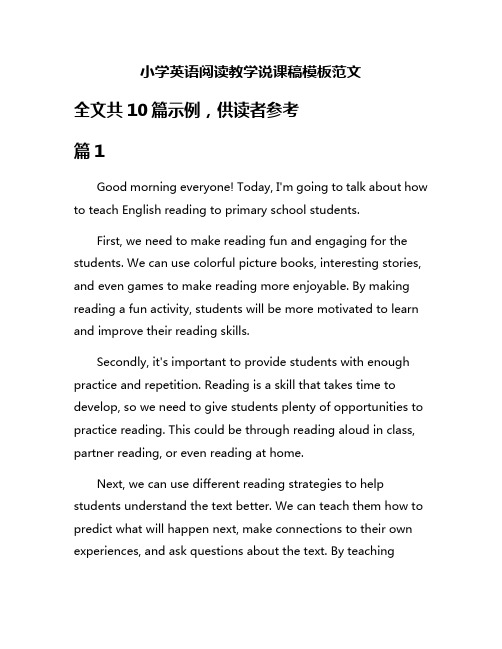
小学英语阅读教学说课稿模板范文全文共10篇示例,供读者参考篇1Good morning everyone! Today, I'm going to talk about how to teach English reading to primary school students.First, we need to make reading fun and engaging for the students. We can use colorful picture books, interesting stories, and even games to make reading more enjoyable. By making reading a fun activity, students will be more motivated to learn and improve their reading skills.Secondly, it's important to provide students with enough practice and repetition. Reading is a skill that takes time to develop, so we need to give students plenty of opportunities to practice reading. This could be through reading aloud in class, partner reading, or even reading at home.Next, we can use different reading strategies to help students understand the text better. We can teach them how to predict what will happen next, make connections to their own experiences, and ask questions about the text. By teachingstudents these strategies, we can help them become more fluent and confident readers.Lastly, we should encourage students to read independently. We can provide them with a variety of books at different levels and genres, so they can choose what interests them. By giving students the freedom to choose what they want to read, we can help them develop a love for reading.In conclusion, teaching English reading to primary school students can be a fun and rewarding experience. By making reading enjoyable, providing practice, using reading strategies, and encouraging independent reading, we can help students become better readers. Thank you for listening!篇2Title: My English Reading LessonHello everyone! Today, I'm going to talk about our English reading lesson. Are you ready? Let's get started!First, we will start by reading a short story together. The story is about a little boy named Tom who goes on an adventure with his dog. As we read the story, I will ask you some questions to check your understanding. Make sure to listen carefully!After reading the story, we will learn some new words. I will write the words on the board and explain their meanings. It's important to learn new words so we can improve our vocabulary.Next, we will practice reading aloud. Each of you will take turns reading a paragraph from the story. Remember to read slowly and clearly, and pay attention to the pronunciation of the words.Then, we will do a fun activity related to the story. We will create our own mini-book using the story we just read. You can draw pictures and write sentences to retell the story. It will be a creative way to practice reading and writing skills.Finally, we will end the lesson by reviewing what we have learned. I will ask you some questions about the story and the new words we learned. You can also ask me any questions you have about the lesson.I hope you enjoy our English reading lesson today. Remember to practice reading every day to become better readers. Thank you for listening! See you next time!篇3Title: My English Reading ClassHi everyone, today I'm going to talk about my English reading class. In our reading class, we learn all about English stories, poems, and even non-fiction texts. We have a lot of fun reading together and discussing the stories with our teacher.First, we start by reading a story together as a class. Our teacher reads out loud, and we follow along in our books. Sometimes we take turns reading paragraphs, and it's really exciting to hear everyone's different voices.Next, our teacher asks us questions about the story. We talk about the characters, the setting, and the main events. It's like we're detectives trying to solve a mystery in the story!After that, we get to do fun activities related to the story. Sometimes we act out scenes from the story, make posters about the characters, or even write our own continuation of the story.At the end of the class, we always have a reading comprehension quiz to see how well we understood the story. It's like a little challenge for us, and we try our best to answer all the questions correctly.I love my English reading class because it's so much fun to read and learn new things. I can't wait for our next story and all the adventures it will bring! Thank you for listening to my say!篇4Today I'm going to talk about how to teach reading to elementary students in English class. Reading is super important because it helps us learn new words, improve our listening skills, and understand different stories.First, we need to make sure the students have a good book to read. We can choose a book that is interesting and appropriate for their level. It's important that the book has pictures to help them understand the story better.Next, we can start by reading the book together as a class. We can ask students to read out loud, and we can also take turns reading different parts of the story. This way, everyone gets a chance to practice their reading skills.After we finish reading the book, we can ask students some questions about the story to see if they understood what they read. We can also do activities like drawing a picture of their favorite part of the story or acting out a scene from the book.Lastly, we can encourage students to read more books on their own. We can recommend other books they might like and create a reading log to track their progress. Reading is a skill thatimproves with practice, so the more they read, the better they will get.In conclusion, teaching reading to elementary students is all about making it fun and engaging. By choosing interesting books, reading together as a class, asking questions, and encouraging independent reading, we can help our students become better readers. Let's keep reading and learning together!篇5Hello everyone, today I'm going to talk about how to teach reading in English to primary school students. Reading is super important because it helps us learn new words, understand different stories, and improve our English skills. So let's get started!When teaching reading to primary school students, it's important to make the lessons fun and engaging. You can start by choosing books that are interesting and age-appropriate for the students. It's also helpful to use pictures and visual aids to help them understand the story better.During the reading lesson, you can use different techniques to help the students understand the text. For example, you canread the story aloud and ask the students to follow along. You can also ask them questions about the story to check their comprehension. It's important to encourage the students to ask questions and make predictions about what will happen next in the story.After reading the story, you can do activities like role-playing, drawing, or writing a summary to help reinforce the students' understanding of the text. You can also encourage them to read the story again at home and discuss it with their families.In conclusion, teaching reading to primary school students is all about making the lessons fun and engaging. By choosing interesting books, using visual aids, and incorporating different activities, you can help the students improve their English skills and develop a love for reading. Thank you for listening, and I hope you found these tips helpful!篇6Title: My English Reading TeachingHello everyone, today I am going to talk about my English reading teaching. In our English class, we have a lot of fun learning new words and stories. Reading is really importantbecause it helps us improve our vocabulary, grammar, and comprehension skills.First, we always start our reading lesson by reviewing the new words we learned in the previous lesson. We go over the pronunciation and meaning of each word, and then we practice using them in sentences. This way, we can remember the words better and use them correctly in our reading.Next, we read a story together as a class. I like to choose stories that are interesting and exciting, so we can all have fun reading them. We take turns reading aloud, and I help the students with any difficult words or phrases. After we finish reading, we discuss the story and answer questions about it. This helps us understand the story better and improve our comprehension skills.Finally, we do some reading exercises to practice what we have learned. We might read a short passage and answer questions about it, or we might do a reading comprehension activity. This helps us reinforce our reading skills and become better readers.In conclusion, reading is a very important part of our English learning. By practicing reading regularly, we can improve our vocabulary, grammar, and comprehension skills. I hope youenjoyed learning about my English reading teaching, and that you will continue to practice reading and improve your English skills. Thank you!篇7Good morning everyone! Today I am going to talk about English reading teaching in elementary school.First, let's talk about why reading is important. Reading can help us learn new words, improve our language skills, and expand our knowledge. It's like going on an adventure in a book!When we are reading, we need to pay attention to the words and the pictures in the book. This can help us understand the story better. We can also ask questions about the story to make sure we understand it.There are many ways to make reading fun. We can read books with our friends, act out the story, or even make our own book to share with others. The most important thing is to have fun while we are reading!As a teacher, I will make sure to choose books that are interesting and at the right level for my students. I will also askquestions and discuss the story with them to help them understand and enjoy reading even more.In conclusion, reading is a wonderful way to learn and have fun at the same time. Let's all remember to read every day and enjoy the magic of books! Thank you for listening.篇8Title: Let's Learn English Reading TogetherHello everyone, today I am going to talk about how to teach English reading to primary school students. Reading is an important skill that helps us learn new things, improve our vocabulary, and have fun! So, let's get started!First, we need to choose a book that is suitable for the students' level. The book should have simple language, interesting stories, and colorful pictures. This will make learning fun and engaging for the students.Next, we should introduce the book to the students and talk about the cover, the title, and the author. We can ask the students to predict what the story might be about based on the cover and title. This will help the students get excited about reading.Then, we can start reading the story together. We should read slowly and clearly, and encourage the students to follow along. We can stop and ask questions to check their understanding, and help them with any new vocabulary.After reading the story, we can have a discussion with the students. We can ask them about their favorite part of the story, what they learned, and how they felt while reading. This will help them think critically about the story and express their opinions.Finally, we can do some fun activities related to the story. We can have the students act out the story, create their own ending, or draw a picture of their favorite scene. This will help reinforce their understanding of the story and make learning enjoyable.In conclusion, teaching English reading to primary school students can be a fun and rewarding experience. By choosing the right book, engaging the students in the story, and doing fun activities, we can help them improve their reading skills and develop a love for reading. Let's continue to learn English reading together! Thank you for listening.篇9Title: My English Reading ClassHi everyone! Today I'm going to talk to you about how I teach English reading in our class. Reading is super important because it helps us learn new words, improve our spelling, and even makes us better at writing.First, I always start by choosing a fun and interesting story to read. It could be about animals, superheroes, or even princesses.I make sure the story is not too easy or too hard, just right for our level.Next, I ask the students to read the story quietly to themselves. This helps them practice their reading skills and understand the story better. After they finish reading, we discuss the main ideas of the story together.Then, I like to do some fun activities to reinforce what we read. We might do a word search, a matching game, or even act out different parts of the story. This way, the students can have fun while learning new words and concepts.Finally, I always encourage my students to keep practicing their reading outside of class. It could be reading books, magazines, or even signs on the street. The more they read, the better they will become at English.In conclusion, reading is a super fun and important part of learning English. I hope you all enjoy reading as much as I do! Thank you for listening and have a great day!篇10Title: My English Reading LessonHello everyone! Today, I'm going to talk about my English reading lesson. We are going to read a story called "The Cat and the Mouse". This story is about a cat who tries to catch a mouse, but he always fails because the mouse is very clever.First, I will show the students the cover of the book and ask them to make predictions about what they think the story is about. Then, we will read the story together as a class. I will ask the students to read out loud and help them with any difficult words.After we finish reading the story, I will ask the students some questions to check their understanding. For example, I will ask them why the cat couldn't catch the mouse and how the mouse outsmarted the cat. I will also ask them to tell me their favorite part of the story and why they liked it.To reinforce their understanding of the story, I will ask the students to draw a picture of their favorite scene from the story and write a sentence describing what is happening in the picture. This will help them remember the story and practice their writing skills.In conclusion, reading is a fun and important part of learning English. By reading stories like "The Cat and the Mouse", students can improve their reading comprehension, vocabulary, and writing skills. I hope my English reading lesson will be enjoyable and educational for my students. Thank you for listening!。
PEP小学英语五年级上册Unit4WhatcanyoudoAReadandwrite阅读教学说课稿

PEP小学英语五年级上册Unit 4 What can you do? A Read and write阅读教学说课稿一、学情分析五年级学生对英语仍然有着浓厚的学习兴趣,对英语充满了好奇心,也具备一定的语言知识和技能。
他们不仅活泼好动,爱听爱说,而且善于口头模仿。
小学生的心理和年龄特点决定了学生对有趣的听、说、唱、做、游戏、玩、演、视听等生动活泼的教学活动更感兴趣。
然而,学生自主阅读的训练相对缺乏,当然也就谈不上对阅读或写作技能、策略、方法的掌握。
二、教材分析本课是一节阅读教学课,以Friends(Play together, help each other)为主线,本课时的子话题是Find a friend to play together。
Read and write分为读、写两部分:第一部分要求学生阅读机器人Robin的一段交友启示,完成判断句子正误的活动;第二部分为个性化的书写活动,要求学生参考电子邮件,写出三个关于自己能做什么或者不能做什么的句子。
新课标主张学生在语境中接触、体验和理解真实的语言,并在此基础上进行学习和运用,以学生为主体,通过有层次地阅读,学会提取本文关键信息的能力和掌握在语境中猜词义的阅读策略,在阅读中增强思考和语言表达的能力。
三、教学目标1、知识目标:(1)能够读懂简单的电子邮件,能用I am... / I can... / I can’t...介绍自己或他人的特点和能力。
(2) 完成判断对错、完成图表、填写词句等活动,理解和正确朗读:Try me! Send me an email, robin@等生词和短语。
(3) 能够掌握并运用本单元的重点内容,在阅读理解的基础上交流讨论,表达和交流自己个性化的看法和想法,完成句子或短文的书写活动。
(4) 乐观积极地看待自己的特点和能力,尝试用英语交朋友。
2、能力目标:(1)能够听说读写本课重点词汇和句型,并能在实际生活中灵活运用。
- 1、下载文档前请自行甄别文档内容的完整性,平台不提供额外的编辑、内容补充、找答案等附加服务。
- 2、"仅部分预览"的文档,不可在线预览部分如存在完整性等问题,可反馈申请退款(可完整预览的文档不适用该条件!)。
- 3、如文档侵犯您的权益,请联系客服反馈,我们会尽快为您处理(人工客服工作时间:9:00-18:30)。
小学英语阅读课说课稿篇一:小学英语优秀说课稿《Unit 1 This Is My Day 》(借鉴参考)Unit 1 This Is My Day尊敬的各位评委老师,大家上午好。
今天很荣幸站在这里说课,我是小学英语组??考生。
今天我说课的内容是Unit1 This Is My Day (说完了就立刻板书)。
接下来我将从教材的分析、学情的分析、教法学法的选用、教具的准备、教学过程的设定和板书设计这六个方面来呈现我的说课。
一、说教材第一个版块说教材,包含三个要点首先说教材地位与作用:本课内容选自人教版英语五年级下册,单元核心内容是学习一天中不同时间段内的学习和生活起居情况的表达,尤其是学会使用频度副词谈论日常生活。
本课时是A部分的Let’s Learn 和Let ’s play,是本部分的第一课时,它是整个模块的重点,占有很重要的地位,为后面课时的学习做铺垫。
然后说教学目标:根据课程标准对本节课的具体要求,针对小学生的心理特点和认知水平,结合教材,本着面向全体学生,使学生全面主动发展的原则,确定本节课的教学目标如下:1、知识目标:掌握本课时主要动词短语:eat breakfast,do morning exercises,have English class,play sports,eat dinner。
2、能力目标:能够听懂问句:When do you do morning exercises/...?并能运用所学动词短语替换句型“I usually ... at ...中的关键词回答问句。
3:情感目标:引导学生养成良好的作息习惯。
最后说教学重难点,其中重点是掌握Let’s learn 中的五个动词短语,并能用这五个短语回答询问作息时间的问题。
难点是掌握五个短语和单词exercises,usually 的正确发音。
二.说学请学生在上册已经对相关内容有部分了解,对时间的表达也比较熟悉,已掌握了一定数量的动词短语如do homework,play football,watch TV,play computer games 等。
因此,活动设计要激活学生的最近发展区,通过不同层次的活动使效率最大化,知识系统化、条理化,促进完整表达的输出。
三、教法,学法为实现以上教学目标,同时贯彻新课标以学生为主体、教师为主导的理念,在本课的教学中我主要采用直观教学法、TPR教学法、游戏教学法和任务型教学法。
通过这些方法,让学生自主地参与到课堂教学的活动中来,并在活动中得到认识与体验,培养良好的英语学习习惯。
结合以上教学方法,学生在学习本课时中主要采用模仿、小组比赛和及时评价法等学习方式。
以小组为单位交流,使学生在互动中互相启发,产生思维的碰撞,同时保证每个学生都有机会参与学习,从而培养学生与伙伴合作的意识与策略,提高人际交往,学生也在独立与合作中调控了自身的学习,变得自信自强。
在评价学生时,应以鼓励为主,兼顾表扬和指正,如good job ,can you have a try, try again,it doesn’t matter等鼓励学生学习,帮助学生有效调控自己的学习过程,使学生获得成就感,增强自信心。
四、教具准备录音机,磁带,书本上五个短语的词卡和图卡,已学动词短语词卡,时间卡数张五、教学过程我准备从以下五个步骤来设计这节课:step1......step2......step3.....step4.....step5.... ..Step 1 awarming-up本步骤主要通过2个活动来完成热身准备的。
1、Englishsong 我会在课一开始就为学生播放Let’s chant部分的歌曲,让学生去感受歌曲中的节奏和韵律,把学生带入学习英语的氛围中。
2、word-game---What’s missing 我会将五张已学过的动词短语词卡贴在黑板上,要求学生根据我所读的动词短语立即跟读,接着我会从黑板上随意抽出一张动词短语词卡,问:What’s missing,然后让学生回答,换不同动词短语词卡玩几次,对表现好的学生进行表扬,如:Good job,这样有利于培养学生学习英语的积极性和兴趣。
接着游戏继续问表现好的学生,T:What do you do on Saturday mornings? 引导此生回答,I do homework 。
T:What do you do on Saturday afternoons? S:I play football。
T:What do you do on Saturday night? S:I watch TV。
T:So is this your day? S:Yes ,this is my day,从而导入本单元主题。
Step 2 presentation这个步骤我设计了两个活动1、展示已学动词短语词卡watch TV问:When do you watch TV? 出示时间卡引导学生回答,I usually watch TV at 2:30.出示eat breakfast的图卡问学生,When do you eat breakfast,出示时间卡引导学生回答,I usually eatbreakfast at7:00出示eat breakfast的词卡,引导学生跟读eat breakfast。
也以同样的方式呈现其他动词短语。
通过图片的直观教学,使学生更牢固地记忆本课时的生词。
(注:边说边板书单词或短语)2、然后我将播放Let’s Learn 部分的录音,让学生跟读,要求学生模仿其语音、语调,掌握动词短语的正确读音。
同时我会特别指导学生exercises,usually的正确发音,突破本课时的难点。
Step 3 practice and consolidation我主要通过以下三个活动来进行巩固操练的。
活动1、游戏,下指令做动作。
老师请一位学习能力较强的学生上讲台当小老师,小老师下Let’s play和新课所学的其他动词短语的指令,邀请班上其他同学做相应的动作,其他同学边做动作边说指令。
这种游戏有利于生生之间的交流,培养生生之间的合作意识,游戏过程当中老师要适当的激励学生,如:can you have a try, try again,it doesn’t matter;游戏结束之后,老师要表扬学生,如:Well done !活动2、然后我会请每组的小组长上讲台根据他们所抽出的动词短语图卡和时间卡进行表演并和班上其余同学进行互动问答,如一组长抽到play sports 3:30。
那么他首先表演play sports的动作,然后其他学生问:What do you do?该生回答: I play sports。
然后他出示时间卡提示其他学生问When do you play sports? 该生回答: I usually play sports at 3:30这一环节让学生巩固本科时的主要句型。
活动3、心有灵犀游戏大赛:全班分成两大组,每组分别派出两名学生,一名学生面向教师,另一名背对教师站好,教师向面对教师的学生呈现一动词词卡的图片,如play sports 面对教师的学生用动作表现看到的景物,背对教师的学生猜动词短语,全班学生判断yes/no 在规定时间内猜对多的小组获胜,并给予一定的奖励Step 4 production拓展延伸学生两人一组配合表演动词短语,一人表演,一人说出这个动作的名称,如:You get up/play sports...老师在教师内走动指导。
Step5 summary and homework六、板书设计本节课的板书我是这样设计的:以标题为中心,标题的左侧贴上本课生词词卡,右册板书重点句型,这样的板书设计力求结构精简,内容完整,帮助学生构建一个完整的知识框架。
我的说课到此结束,thank you for your listening!篇二:小学英语说课稿全英文整理版Good afternoon, ladies. I am number_______. I’m glad to share my lesson with you.My teaching content today is of Unit of PEP Primary English,Book This unit is mainly aboutNow, I will explain the lesson from the following aspects.1. 教学内容 (Contents)Firstly, let’s focus on the analysis of teaching content.The lesson is a new one of Unit .This unit introduces and develops the theme of“___________”, Ss are expected to master the new words___________________ andto use the sentence patterns___________________ in proper situation. The teachingmaterial mainly describes ___________________ , and it shows all of the newknowledge points.Therefore, it is in the important position of this unit. If Ss can master it well, it will bebenefit for them to learn the rest of the unit.2. 教学目标 (Teaching aims)Secondly, it is about the teaching aims.According to the new curriculum standard and the syllabus, and after studying theteaching material and the facts of the Ss, I set the teaching aims as follows:1, Knowledge objects1) Ss can understand the content correctly. They can read and play the dialogue;2) Ss can listen, read, speak and write the core words_______________;3) Ss can use the sentence patterns ____________- properly.2, Ability objects1) To train Ss’abilities of listening and speaking;2) To train Ss’ ability of working in groups.3, Moral objectsTo foster Ss’ consciousness of good cooperation and proper competition.and difficult pointsAccording to the syllabus,the important points: have Ss fully understand the content,help them to read and play the dialogue.The difficult points: 1) Help Ss to read the dialogue fluently, and help them to readand play the dialogue; 2) make sure they can read the core words correctly.4.教法学法(Teaching methods)Fourthly, it talks about teaching methods.In this lesson, I will mainly use “Task-based teaching method”, “Communicativelanguage teaching method” and “TPR teaching method”, and so on.5.教学过程Next, let’s focus on the teaching procedures.I will finish the lesson in steps.It will cost about mins.After greeting with the Ss, I will begin the lesson by singing the song together with the Ss.Purpose:The purpose of this is to form a better Englishlearning surrounding for the Ss, and,at the same time, it provides situations to review the learned knowledge for the next step.It will cost about mins.With the help of the PPT, I set a situation of by to stimulate the Ss’ interest of the lesson.By playing the PPT, IAnd then,(板书layout)The purpose of this is to present the new words and sentences in the situation, whichrelates to the Ss’ real life experiences, to help the Ss understand the language easilyand naturally.After presenting each new word (by the guessing game), I will impart the knowledgeof pronunciation rules in teaching the new words.It is called Phonics.It can facilitate the Ss’ abilities to pronounce the words, and help them to rememberthe spelling of the words.It will cost mins, includingDue to the Ss’ age, I makeThe purpose of this is to draw the whole Ss’attention to the spelling of the words.It is to help Ss to learnthrough a true situation.In this step, I will give Ss a free space to show their abilities.I will Then, Task-based teaching method and Communicative language teaching are used here.The activity is to develop Ss’ability of communication, and also, their ability ofcooperation will be well developed.Making a new dialogue is to check if Ss can use correctly and skillfully.In this step, I will guide the Ss to conclude the key wordsAnd sentences And also, I willThe purpose of this is to stimulate Ss’ interest of learning English and wide their knowledge about communication across cultures.6.板书再次介绍(Talking about the blackboard design again)And, this is my layout design.That’s all for my teaching design. Thank you a lot for listening.篇三:小学英语说课稿小学英语说课稿:《Read and write》范文今天我说课的内容是PEP小学英语五年级上册第六单元 In a nature Park A部分的第三课Read and write.PEP教材从四年级开始出现这种课型,但五年级的读写课明显与四年级不同,其教学目标是:在有限的课堂时间内,读懂与单元话题相关的趣味对话或短文;完成检测学生阅读理解程度的练习;听、说、读、写四会掌握一组句子;适当扩展语言,完成一项综合运用所学语言的任务型语言活动。
